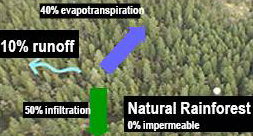Most natural watersheds around Victoria consist of mature forests, sometimes interspersed with open meadows. In these regions of abundant vegetation, evapotranspiration is a significant process (see
The Water Cycle): water evaporates from the soil and from water intercepted by the plant leaves, and transpires through pores in the leaves. Approximately 40% of precipitation in forested areas is returned to the atmosphere through evapotranspiration.
Natural Watersheds

The soil in forests consists of a large amount of plants, fungi and decaying organic material that collectively acts as a sponge by soaking up moisture and encouraging infiltration. Approximately 50% of the precipitation in forests infiltrates the soil. Therefore only 10% of precipitation in natural watersheds flows across the surface into streams and other water bodies, and it is highly filtered on the way by plant roots and forest litter.
Urban Watersheds
In urban areas, on the other hand, large expanses of roads, parking lots, and roofs of buildings replace the forest and organic soils. These impervious surfaces do not allow water to soak into the ground. Consequently, infiltration in urban areas accounts for only 5 to 35% of rainfall. Evapotranspiration is also substantially reduced, to 20-35%, due to a lack of vegetation. Therefore, 30% to 70% of rainfall in urbanized watersheds runs off almost immediately into storm drains and subsequently into natural water bodies.

Increased runoff creates a number of problems:
- When water flows over urban impervious surfaces, it picks up pollutants such as oil, gasoline, cigarette butts, fertilizers, pesticides, and industrial chemicals. As there is little vegetation, these substances are usually not filtered before being washed into water bodies where they can seriously harm aquatic organisms (see also Pollution).
- The volume of water flowing off urban areas is much greater compared to natural areas. The great energy in these torrents of water can cause erosion, which destroys stream channels and banks, wildlife habitat and adjacent property.
- Erosion caused by the large water volumes also deposits sediment in low-energy downstream areas such as at the mouths of rivers. This can smother bottom-dwelling plants and animals as well as destroy fish spawning and bird feeding habitat.
- Water flows in urbanized watersheds are significantly altered compared to natural flows. For example, very little water is stored in watersheds with large areas of impervious surfaces; this results in large peaks in stream flows immediately after a rainstorm, followed by very low flows soon after. These extreme conditions are inhospitable for most fish and aquatic invertebrates. Dams, dykes and water retaining walls also alter flows.
These problems are now beginning to be addressed by local governments, planners and citizens. Efforts are being aimed at reducing the amount of water that flows off the land in urban areas, and increasing infiltration.
Additional Information & Links